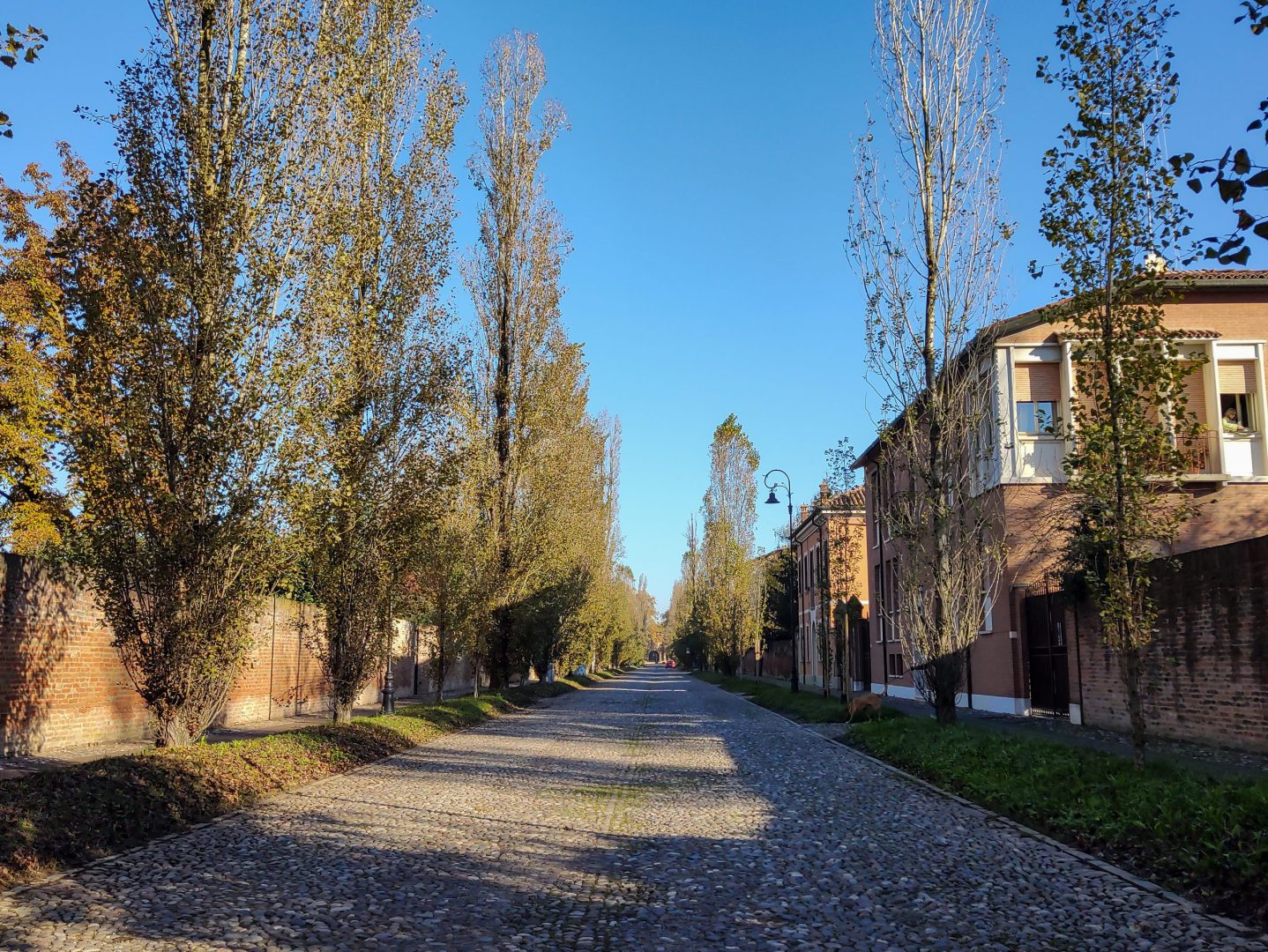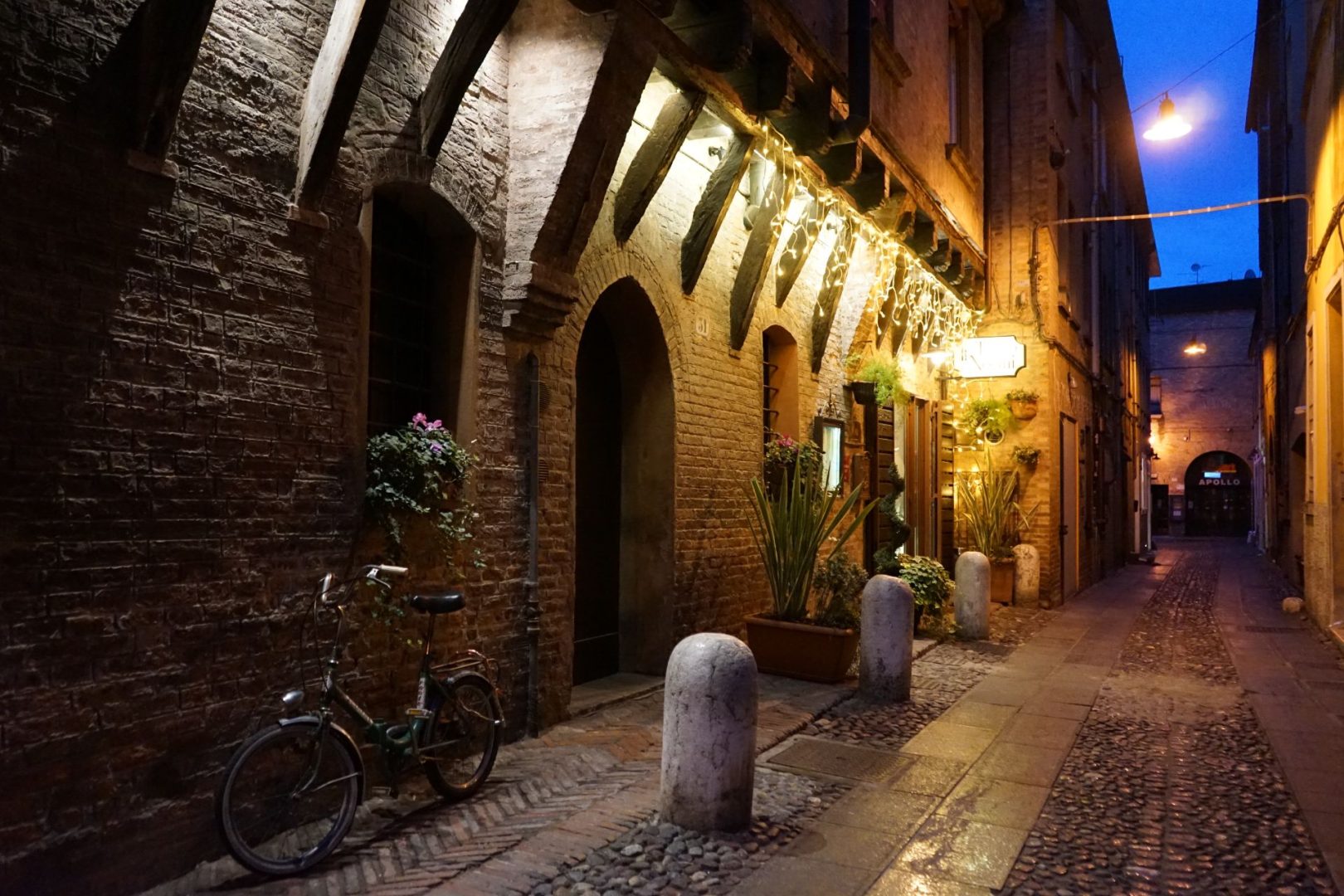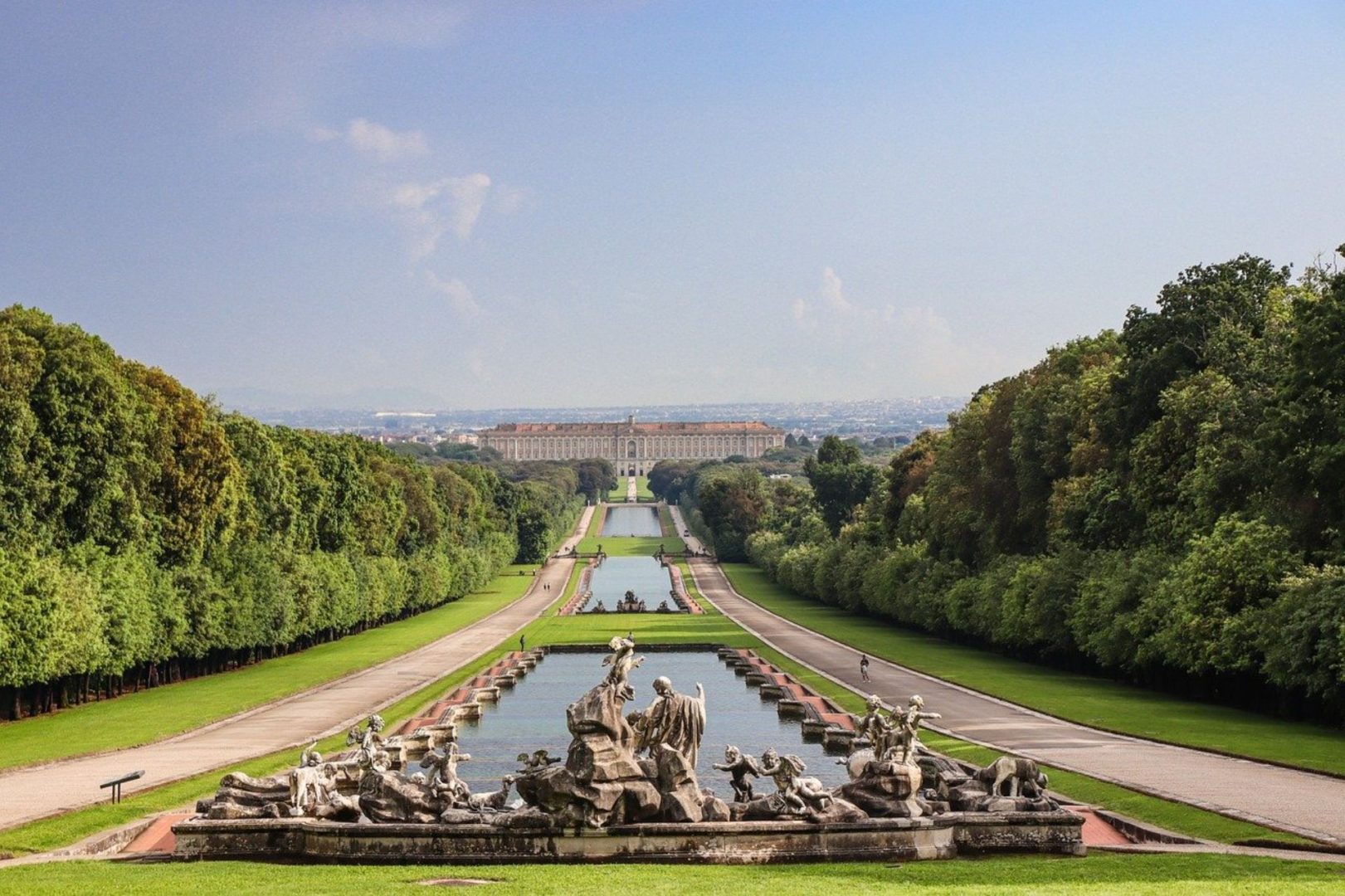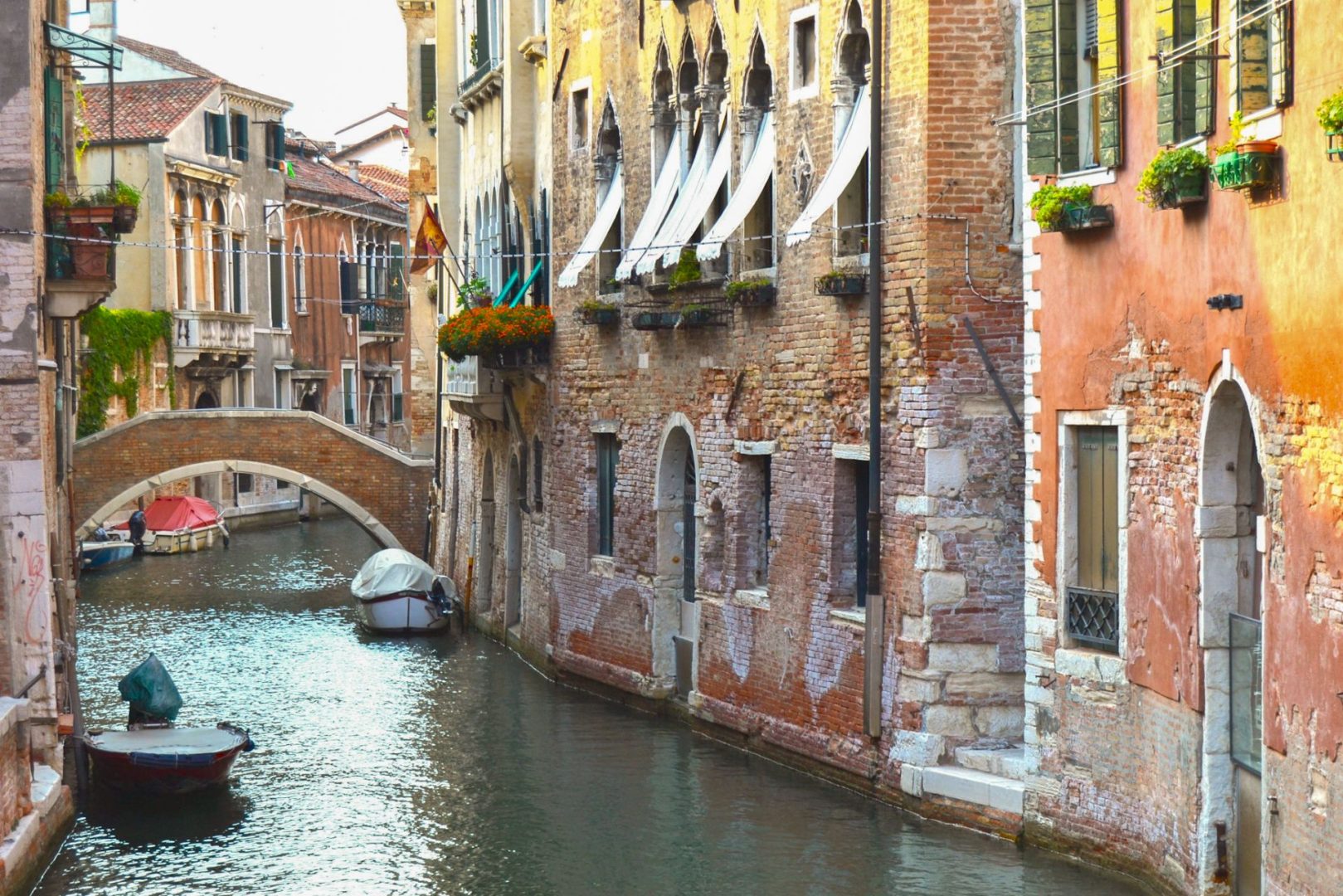Prepare yourself for an immersive journey into the heart of the Italian Renaissance, for that’s precisely what awaits you when visiting Ferrara. Located on the banks of the Po River in the Emilia Romagna region, Ferrara saw the birth of Europe’s first modern town planning project. Centuries later, this distinction earned it the coveted UNESCO World Heritage Site status as the Renaissance city that embodies the humanist vision of the ‘ideal city’.
Dominating Ferrara’s historic center is a monumental castle, complete with an authentic drawbridge and a water-filled moat—a rare sight in Italy. And wandering through its cobblestone streets – perhaps on a bicycle, the locals’ favorite mode of transport – you’ll find yourself immersed in the timeless allure of cobblestones, delightful brick-hued houses, and charming eateries.
Yet, Ferrara is more than just a display of architectural marvels. It proudly boasts a captivating roster of iconic figures who were either born or lived within its confines – from the stern inquisitor Savonarola and the influential Este dynasty to the brilliant author of “Orlando Furioso,” Ariosto, and Noble Prize winner Giulio Natta. So, if, like me, you crave enthralling narratives, then make sure to add a trip to Ferrara to your Italy itineraries.
A bit of Ferrara history to set the stage
In 753 AD, the name Ferrara made its historic debut in a document confirming Lombard rule over the region. Following the defeat of the Lombards in 774, Charlemagne granted Ferrara to the Pope, and by 984, the area evolved into a fiefdom under the control of the Count of Canossa, a nephew of Emperor Otto I.
Around 1100, Ferrara blossomed into a free commune, sparking a tumultuous era marked by relentless power struggles among local families. It was during this period that the Este family emerged, orchestrating a strategic union with the local Adelardi clan.
Under the Este family’s patronage, Ferrara thrived for over three centuries. The city evolved into one of the most sophisticated cultural centers of the Italian Renaissance, rivaling cultural rockstars like Florence, and the Este court attracted great artists of the time, from Leon Battista Alberti to Andrea Mantegna.

The Este family also left an indelible mark on Ferrara’s landscape through visionary urban planning projects known as Addizioni (additions). Among these, the Addizione Erculea, named after Duke Ercole I, stands out as a masterpiece by court architect Biagio Rossetti, transforming Ferrara into Europe’s first modern city. The Estensi family’s efforts extended to the city’s surroundings, with the construction of several beautiful estates dedicated to the art of leisure, known as Delizie (“delights”).
Although reclaimed by the Pope in 1598, Ferrara endured, experiencing a 19th-century renaissance thanks to its agricultural prowess. Today, the city boasts a high quality of life, hosting lots of interesting events such as the Buskers Festival, the Balloons Festival, and the Palio di Ferrara.
The top things to see in Ferrara
Ferrara is a relatively small city, yet it’s packed with beautiful sights and landmarks that seamlessly blend the Middle Ages and the Renaissance eras. While many only spend one day in Ferrara, I recommend dedicating at least a couple of days to truly absorb and savor its distinct charm.
The Estense Castle
At the heart of Ferrara stands the Estense Castle, a fairy-tale fortress featuring towers, drawbridges, and a water-filled moat. Built in 1385 for defense against internal uprisings triggered by oppressive taxes, it later transformed into a revered court palace.
Today, you can cross one of those drawbridges and explore its interiors, boasting opulent frescoes, underground prisons adorned with graffiti, a delightful orange garden, and the Tower of the Lions – the castle’s oldest tower, offering panoramic city views.

Like any captivating castle, the Estense Castle has its share of intriguing tales, including the story of Ugo and Parisina. At just 15, Parisina was forced to marry Marquess Niccolò III d’Este, known for his tumultuous love life (think three official wives, countless lovers, and numerous offspring). But she fell in love with Ugo, Niccolò’s 14-year-old son, and when their forbidden love was discovered, Niccolò sentenced them to death, extending the punishment to all unfaithful women of Ferrara.
For a family-friendly experience, consider a boat tour along the castle’s moat – a fun activity providing a unique perspective on Ferrara’s symbol.
The Cathedral of San Giorgio
From the castle, pass through the Municipal Palace and reach the Cathedral Square, where the magnificent church dedicated to Saint George proudly stands. Dating back to 1135, this architectural marvel is a testament to centuries of artistic evolution, showcasing a grand blend of styles.
Renowned architect Nicolò, famed for iconic structures like the Sacra di San Michele near Turin and the Cathedral of San Zeno in Verona, designed the structure. The bell tower, on the other hand, was a creation by Leon Battista Alberti.
The grand facade, adorned with white marbles and pinkish hues, boasts intricate carvings of arches, columns, and statues. Inside, the Baroque-styled interior is home to the tomb of Pope Urban III and masterpieces like Guercino’s “Martyrdom of Saint Lawrence” and Bastianino’s “Universal Judgment,” inspired by Michelangelo’s Sistine Chapel.

Just a few meters away, the Cathedral Museum treasures valuable works, including Jacopo della Quercia’s “Madonna della Melagrana” and organ’s doors by Cosmè Tura.
Here’s a fun fact: the Ferrara Cathedral’s name is engraved on the floor of the central nave of St. Peter’s Basilica, which lists the 26 largest churches globally. With a length of 118 meters, this cathedral proudly holds the twentieth spot.
The Jewish quarter
The southern side of the Cathedral overlooks Piazza Trento e Trieste, the lively meeting place for the people of Ferrara (for a unique vantage point, head up to the second floor of the “Il Libraccio” bookstore). At the end of the square, you’ll find Via Mazzini, which leads you into the heart of the old Jewish ghetto.
Established in 1627 and persisting until the unification of Italy, this historic enclave was a segregated community. However, the Jews had been living in Ferrara long before the ghetto was established, peacefully integrating with the local population under the protection of the Este rulers.
Their rich history of this community unfolds along Via Mazzini and adjacent streets like Via Scienze, Via Vittoria, Via Contrari, and Via Vignatagliata. Giorgio Bassani’s renowned novel “The Garden of the Finzi-Continis” vividly depicts this area’s past.
Don’t miss the Jewish cemetery on Via delle Vigne, in use since the 17th century. Despite its weathered appearance, I found it utterly fascinating. And to know more about Jewish life in Italy, extend your exploration by visiting the National Museum of Italian Judaism and the Shoah on Via Piangipane.

Don’t miss the Jewish cemetery on Via delle Vigne, in use since the 17th century. Despite its weathered appearance, I found it utterly fascinating. And to know more about Jewish life in Italy, extend your exploration by visiting the National Museum of Italian Judaism and the Shoah on Via Piangipane.
Palazzo Schifanoia
Take a delightful 10-minute stroll through the atmospheric streets of the old Jewish ghetto, and you’ll arrive at Palazzo Schifanoia. Commissioned by Alberto d’Este in the 14th century, this palace was designed for pure amusement and entertainment, living up to its name – “escape from boredom.” It is one of the many villas erected by the Este family across the Ferrara landscape to relish la dolce vita, aptly named Delizie (delights).
However, it was Duke Borso d’Este, who gave the palace its major highlight. In 1469, he asked the artists of the Ferrara workshop, led by Cosmè Tura, to adorn the main hall, a project that also involved the court astrologer. Upon entering the colossal room, stretching an impressive 23 meters in length and 11 meters in width, you’ll be enthralled by walls embellished with 12 vertical compartments. Each depicts a specific month, with the corresponding zodiac sign and scenes from daily life under Borso d’Este’s rule. So beautiful that it’s etched its place in Italian Renaissance history.

Keep an eye out for the fresco related to the month of July, featuring women processing hemp, a nod to Ferrara’s prominence in hemp production. By the way, according to folklore, the fumes from this plant were believed to drive the Ferrarese people crazy!
Here’s a tip: just steps from Palazzo Schifanoia, don’t miss the Church of Santa Maria in Vado, one of Ferrara’s most beautiful churches. It’s renowned for the miracle Easter Sunday in 1171, when blood flowed from a host, reaching the vault above the altar!
Palazzo Diamanti
Palazzo dei Diamanti is another splendid Renaissance masterpiece in Ferrara, located within the Addizione Erculea. Its name derives from the remarkable facade, a creation of the court architect Biagio Rossetti. It’s a marvel adorned with over 8,000 white marble blocks arranged to mimic the facets of a diamond, hence the name.

Each block was positioned to optimize the reflection of light, enhancing the overall beauty of the structure. Legend has it that Ercole I hid a real diamond from his crown underneath one of these marble blocks. The secret of its location was shared with only one other person – the master mason – who paid a heavy price for knowing too much – Ercole had his tongue cut to keep the secret safe!
Venturing inside, you’ll find the Pinacoteca Nazionale showcasing exquisite paintings from the Ferrara school (look for Dosso Dossi’s monumental Costabili Polyptych). Additionally, the palace features an exhibition space hosting various art exhibitions throughout the year.
Corso Ercole I d’Este
Palazzo Diamanti is located on Corso Ercole I d’Este, an enchanting street adorned with historical treasures that connects the Estense Castle to the Porta degli Angeli along the ancient city walls. This grand corridor was a key part of the Erculean Addition, the grand project that reshaped Ferrara in the late 15th century.
What sets this street apart is not only its aesthetic allure but also the absence of commercial distractions—proudly holding the distinction of being the longest European street without shops!
The historic buildings lining this street each tell enthralling tales, contributing to an atmosphere of timeless beauty. Among them is Palazzo Gulinelli, whose owners finances Mister Bugatti for the creation of the very first Bugatti car, which was due to become a legend.

Cycling along Corso Ercole was an absolute delight. As I pedaled away from the town center, the stately palaces gradually gave way to colorful houses and rows of trees, creating a countryside-like atmosphere.
Getting lost in Ferrara’s historic streets
Ferrara’s streets are like real-life paintings. Seriously, getting lost in these ancient lanes is one of the coolest things to do in Ferrara. They whisk you back in time, and when the sun and when sunlight bathes the cobblestones, it transforms the surroundings into a photographer’s paradise!
While Via delle Volte is the most famous, there are many others well worth exploring. Take Via Aldighieri, for instance, where the Church of San Biagio cradles a crypt containing the remnants of Dante’s ancestors. Or Via Porta San Pietro, where an old church was transformed into a red-light cinema (the Mignon, now closed but you can still see the sign)!
Also, take note of Via Ragno, Via Coperta, Via Zemola, and Via San Romano – all incredibly beautiful streets! Plus, you’ll stumble upon very curious street names that reveal insights into the past. Like Via Giuoco del Pallone (literally, “football street”), named so because it used to be where kids once ruled the asphalt with their soccer games!

More things to do in Ferrara
If you’ve got some extra time, you should totally check out these awesome additions for your Ferrara itinerary. They’ll make your trip even more amazing!
The Monumental Cemetery
Six centuries of history and six hectares of grounds: this is the Monumental Cemetery in Ferrara, a real open-air museum with beautiful works of funerary art.
Commissioned in the second half of the 15th century by Duke Borso d’Este, the Certosa began its existence as a Carthusian monastery, mirroring the magnificence of the Certosa di Pavia (Borso secretly wanted to emulate the grandeur of the Duke of Milan). With the Napoleonic era, the site became a military barracks and then in 1813, it transformed again into the monumental cemetery that stands today.

Walking through this monumental cemetery is like flipping through the pages of Ferrara’s history book. This is where the city’s most prominent characters rest in peace. From the rockstar Borso d’Este to the film director Michelangelo Antonioni and the landowners Severino and Gustavo Navarra, founders of a School of Agriculture that remains active to this day.
For those intrigued by the prospect of unraveling the stories hidden within the cemetery, a guide with thematic routes is available for download on the official website.
Monastery of Sant’Antonio in Polesine
If you enjoy art, then I recommend visiting also the Monastery of Sant’Antonio in Polesine, which houses exquisite frescoes from the Giotto school. Founded in the 13th century by Beatrice d’Este, daughter of Marquis Azzo VII d’Este, it served as the sacred venue where the city’s elite girls’ took their vows. Today it’s home to a tiny community of Benedictine nuns.
The monastery is open from Monday to Saturday (9:30 am – 11:30 am and 3:15 pm – 4:45 pm), but it’s best to check online before visiting. Upon arrival, simply ring the bell, and one of the nuns will open the door to guide you through the chapel and the frescoes depicting religious tales in a unique way. For example, in the crucifixion scene, Jesus is portrayed ascending the cross using a ladder.

During the visit, you will also see the space containing Beatrice’s remains, which is renowned for a marble slab that mysteriously drips water – a phenomenon that stands out in the otherwise dry environment and is considered miraculous.
To enhance the experience, time your visit to coincide with the daily 5:00 pm Vespers service, so you can enjoy the Gregorian chants performed by the nuns.
Embark on a water journey aboard the Nena
A relaxing river excursion with “La Nena,” a restored historic boat moored in the Darsena di S. Paolo, is a fun thing to do in Ferrara when you have a bit extra time. The boat is named in honor of Nazarena Casini, known as Nena, who was only 13 years old when she began rowing on the river to ferry goods and people from one bank to the other.
Operating seasonally from April to October, “La Nana” offers various itineraries that allow you to soak in the natural beauty of the Po River. Be sure to secure your spot by making a reservation, you can find all the details on their website (don’t forget to pack some mosquito repellent, especially in summer).
Tips for visiting Ferrara
- If you’re planning to travel to Ferrara by car, keep in mind that the historic center is a Limited Traffic Zone (ZTL). It’s best to leave the car at the “Centro Storico” parking facility on Via Darsena, operating 24/7 and priced at a maximum daily rate of €3.20 for the day (free on holidays). For a free option, consider the “Ex Mof” parking also located on Via Darsena, which is about 15 minutes walk from the Estense Castle (it’s unattended, though).
- For those arriving by train from major Italian cities, a pitstop in Bologna is likely. Upon reaching Ferrara, it’s a 20-minute stroll to the city center. Alternatively, bus options include #6 or #11, with the Cavour-Giardini stop being the closest to the Estense Castle.
- A great time to visit Ferrara is in May during the Palio di Ferrara, the world’s oldest along with the one in Asti (it is said to date back to 1259!). The entire month is packed with lively celebrations, with parades and competitions among the city’s contrade.
- When in Ferrara, be sure to indulge in local culinary delights such as the iconic Ferrarese bread known as “coppia,” paired with local cured meats. Additionally, savor the unique flavors of cappellacci di zucca al ragù and pasticcio ferrarese, both offering a delightful blend of sweet and savory, and try the salama da sugo, a pork delicacy served with creamy mashed potatoes. And, of course, do not forget to taste Ferrara’s caviar!
- For souvenirs, stock up on local delights at Drogheria Salumeria Montanari. Also, check out the artisanal creations at Nido and the ceramic of La Bottega delle Stelle. For bibliophiles, don’t miss the charming Sognalibro bookshop.
Ciao for now,







